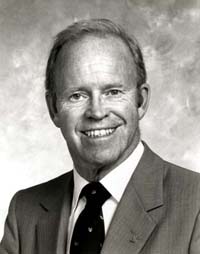Philip B. Crosby
| Philip B. Crosby |
|---|
| See also |
Philip Crosby worked on quality for 40 years, including 14 years spent at ITT. Thanks to the use of Total Quality Management (TQM), the ITT company saved at this time $ 720,000,000. He gained knowledge while moving up from lower levels of the organizational hierarchy (he started as an inspector) up to the board vice president. His most famous book, Quality is Free was published in over one million issues.
Biography
He was born in 1926 in Whelling in West Virginia, and died in 2001. In 1952 he began work on a production line. Gradually over the years, he climbed up the career ladder. He worked for Crosley, Martin-Marietta and ITT. In 1979 he created a consulting firm that dealt with the popularization of preventive approach to quality, in place of the audit approach. In the 90s he provided lectures and seminars on quality.
The most important dates:
- 1952 - work for Crosley
- 1955 - Bendix Mishiwaka
- 1957 - Martin Marietta
- 1964 - Distinguished Civilian Service Medal from the Department of the Army
- 1964 - development of Zero defects concept
- 1965 - ITT (vice president of quality)
- 1979 - founded Philip Crosby Associates, Inc.
- 1991 - retirement from PCA and foundation of Career IV, Inc.
- 1997 - founded Philip Crosby Associates II, Inc.
Quality is free
Philip B. Crosby is the author of "Quality is free" - his most popular book. But it's not only the title - it's the philosophy. In Crosby's view, all investments in improvement of quality (prevention, training, improvement of products and processes, etc.) lead to decline in costs of low quality (defects, [[7 wastes of lean|waste], etc.). The decline is greater than those investments. It means that despite the investments, costs of whole enterprise decline. Therefore, the increase of quality costs nothing - the quality is free.
Crosby is the author of process cost model - a model of quality costs accounting - which enables enterprises to detect costs of good and bad quality. The model was described in "Quality is free" book.
Zero defects
Zero defects - the method of assuming that is possible to completely eliminate the deficiencies through proper organization of processes, training of personnel, maintenance of infrastructure.
The method of zero defects was used with success for the first time in the armaments industry. It was later popularized in civilian industries. It gave rise to a number of methods for integrating the principles of management and statistics. Crosby was not seen by all as a guru of quality. William Edwards Deming has repeatedly denied his achievements.
The idea is based on four absolutes defined by P.B. Crosby:
- Quality is conformance to requirements
- Defect prevention is preferable to quality inspection and correction
- Zero Defects is the quality standard
- Quality is measured in monetary terms – the Price of Nonconformance
14 steps to improvement
Philip B. Crosby defined 14 steps to improvement. They are a competitive approach to W. Edwards Deming's 14 principles.
- Commitment of Management
- Formulate the Quality Improvement Team
- Measure for Quality in Current Practices
- What Will the Cost of Quality Be?
- Quality Awareness is Central to Success
- Remember the Quality Problems? Take Corrective Action
- Plan for Zero Defects
- Practice Effective Training for Supervisors
- Happy Zero Defects Day!
- Involve Everyone in Goal Setting
- Eliminate Causes of Errors
- Implement Recognition for Participants
- Create Quality Councils
- Lather...Rinse...REPEAT!!!
References
- Philip Crosby Associates
- Love, C. E., Guo, R., & Irwin, K. H. (1995). Acceptable quality level versus zero-defects: some empirical evidence. Computers & operations research, 22(4), 403-417.
- Crosby P.B. (2006) Crosby's 14 Steps To Improvement, www.asq.org
